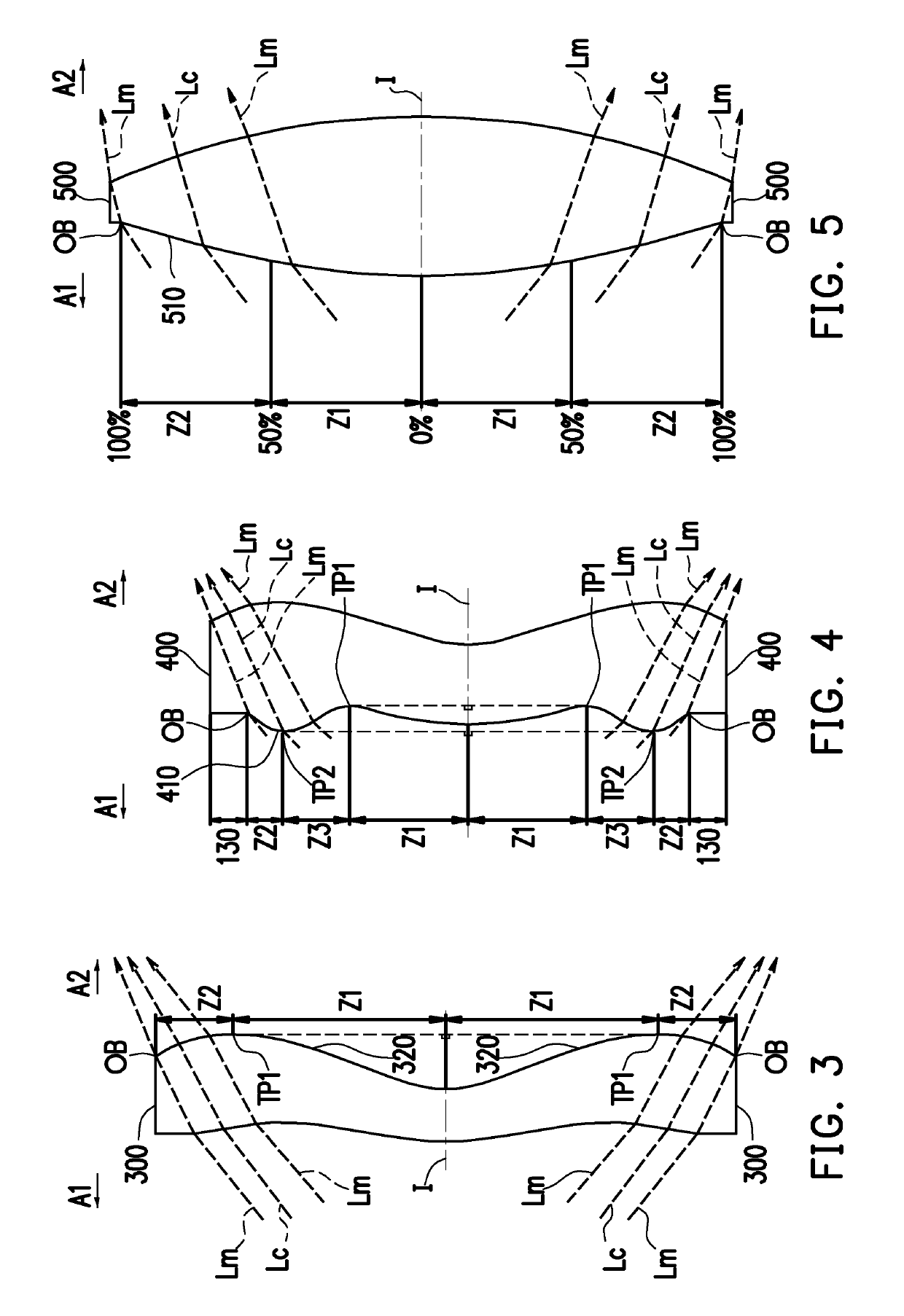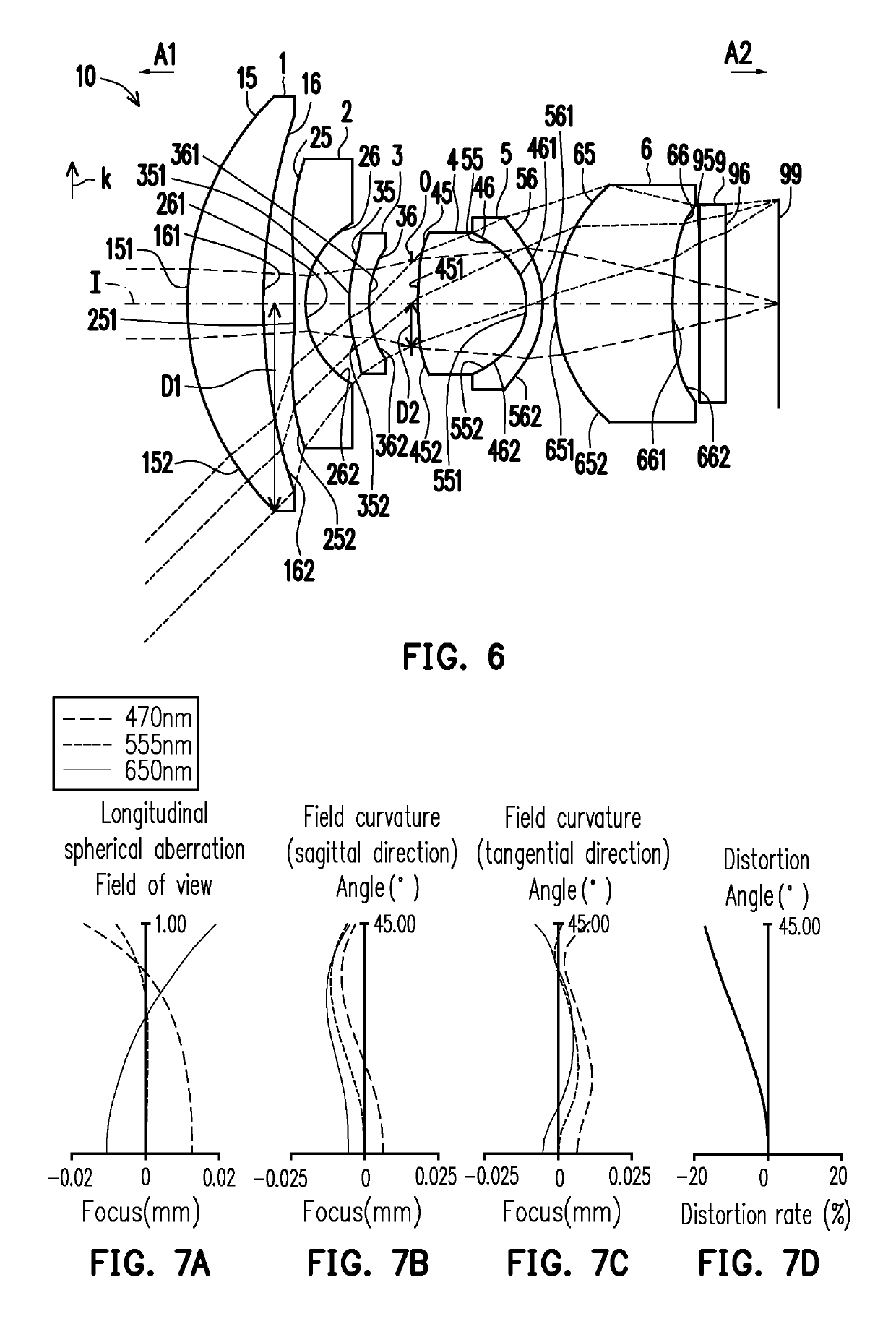Optical imaging lens
a technology of optical imaging and optical lens, applied in the field of optical devices, can solve the problems of inability to manufacture optical lenses with both a miniaturized size and desirable imaging quality, and still fall behind the imaging quality of optical lens assemblies for vehicles, and achieve the effect of desirable optical performan
- Summary
- Abstract
- Description
- Claims
- Application Information
AI Technical Summary
Benefits of technology
Problems solved by technology
Method used
Image
Examples
first embodiment
[0079]In the first embodiment, the aperture stop 0 is disposed between the third lens element 3 and the fourth lens element 4. The aperture stop 0 has a radius D2. The radius D2 of the aperture stop 0 refers to a distance between an optical boundary (i.e., a point where a radially outermost marginal ray passing through the aperture stop 0 intersects the aperture stop 0) of the aperture stop 0 and the optical axis I of the optical imaging lens 10 in a radial direction k. In addition, the radial direction k is perpendicular to the optical axis I.
[0080]The fourth lens element 4 has positive refracting power. An optical axis region 451 of the object side surface 45 of the fourth lens element 4 is convex, and a periphery region 452 of the object side surface 45 of the fourth lens element 4 is convex. An optical axis region 461 of the image side surface 46 of the fourth lens element 4 is convex, and a periphery region 462 of the image side surface 46 of the fourth lens element 4 is convex...
second embodiment
[0145]Respective aspheric coefficients of the object side surface 25 of the second lens element 2 to the image side surface 66 of the sixth lens element 6 of the second embodiment in Equation (1) are as shown in FIG. 13.
[0146]In addition, relations of important parameters in the optical imaging lens 10 according to the second embodiment are as shown in FIGS. 46 and 47.
[0147]The longitudinal spherical aberration of the second embodiment is shown in FIG. 11A, and imaging point deviations of the off-axis rays in different heights are controlled within a range of ±0.025 mm. In FIGS. 11B and 11C illustrating the astigmatic field curves, focal distance variations of the three representing wavelengths in the whole field range fall within ±0.025 mm. The distortion aberration shown in FIG. 11D indicates that the distortion aberration of the second embodiment is maintained within a range of ±10%.
[0148]Based on the above, the Fno of the second embodiment is less than the Fno of the first embod...
third embodiment
[0151]Respective aspheric coefficients of the object side surface 25 of the second lens element 2 to the image side surface 66 of the sixth lens element 6 of the third embodiment in Equation (1) are as shown in FIG. 17.
[0152]In addition, relations of important parameters in the optical imaging lens 10 according to the third embodiment are as shown in FIGS. 46 and 47.
[0153]The longitudinal spherical aberration of the third embodiment is shown in FIG. 15A, and imaging point deviations of the off-axis rays in different heights are controlled within a range of ±0.025 mm. In FIGS. 15B and 15C illustrating the astigmatic field curves, focal distance variations of the three representing wavelengths in the whole field range fall within ±0.050 mm. The distortion aberration shown in FIG. 15D indicates that the distortion aberration of the third embodiment is maintained within a range of ±8%.
[0154]Based on the above, the distortion aberration of the third embodiment is less than the distortion...
PUM
 Login to View More
Login to View More Abstract
Description
Claims
Application Information
 Login to View More
Login to View More - R&D
- Intellectual Property
- Life Sciences
- Materials
- Tech Scout
- Unparalleled Data Quality
- Higher Quality Content
- 60% Fewer Hallucinations
Browse by: Latest US Patents, China's latest patents, Technical Efficacy Thesaurus, Application Domain, Technology Topic, Popular Technical Reports.
© 2025 PatSnap. All rights reserved.Legal|Privacy policy|Modern Slavery Act Transparency Statement|Sitemap|About US| Contact US: help@patsnap.com



